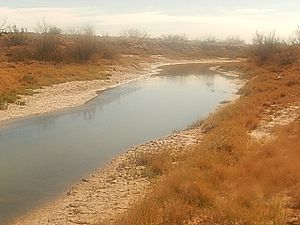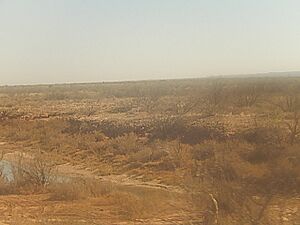Horsehead Crossing facts for kids
Quick facts for kids Horsehead Crossing |
|
|---|---|

Horsehead Crossing as it appears in 2014
|
|
| Type | Ford |
| Location | Pecos County, Texas |
| Nearest city | Girvin, Texas |
| Elevation | 2,316 feet (706 m) |
| Governing body | State of Texas |
| Official name: Horsehead Crossing on the Pecos River | |
| Designated | 1936 |
| Marker Number | 2564 |
| Atlas Number | 5371002564 |
| Lua error in Module:Location_map at line 420: attempt to index field 'wikibase' (a nil value). | |
Horsehead Crossing is a special place on the Pecos River in Crane County, Texas. It's a "ford," which means a shallow spot in a river where people and animals can cross. For a long time, this was one of the only easy places to cross the Pecos River in West Texas. It was also the first reliable water source for travelers coming from the east, after a long, dry journey.
The exact spot of Horsehead Crossing is marked by a historical sign at 31°14' N, 102°29' W.
Contents
History of Horsehead Crossing
Horsehead Crossing was a very important spot for many years. Long ago, Native Americans likely used this crossing. Later, it became a main crossing point for the Comanche Trail. This trail was used by the Comanche people to travel from the Llano Estacado (a large plateau) south into Mexico.
Mapping the Trail
In 1849, a man named Randolph B. Marcy mapped this ford. He was leading an army group helping people travel to California. They were using the San Antonio-El Paso Road.
A Stop for Mail and Cattle
By 1858, Horsehead Crossing became a key stop for the Butterfield Overland Mail. This was a famous stagecoach route that carried mail and passengers from St. Louis all the way to San Francisco.
A few years later, in 1866, two cowboys named Charles Goodnight and Oliver Loving started their famous cattle trail. This trail brought huge herds of cattle to Horsehead Crossing. From there, the cattle would turn and travel upriver.
The End of an Era
In the early 1880s, things changed. People started using railroads more often to move goods and cattle. Two new railroads were built across West Texas. Because of this, the old cattle drives became less common. Horsehead Crossing was no longer needed as much, and it was eventually abandoned.
How Horsehead Crossing Got Its Name
The name "Horsehead" has an interesting story. People say that horse skulls were used to mark the banks of the river at the crossing.
There are a few ideas why these skulls were there:
- The Comanche people might have placed them to make the crossing easier to find.
- Many animals, especially horses, died at the crossing. This could have happened from drowning, getting stuck in quicksand, or drinking too much water after a long, thirsty journey.


